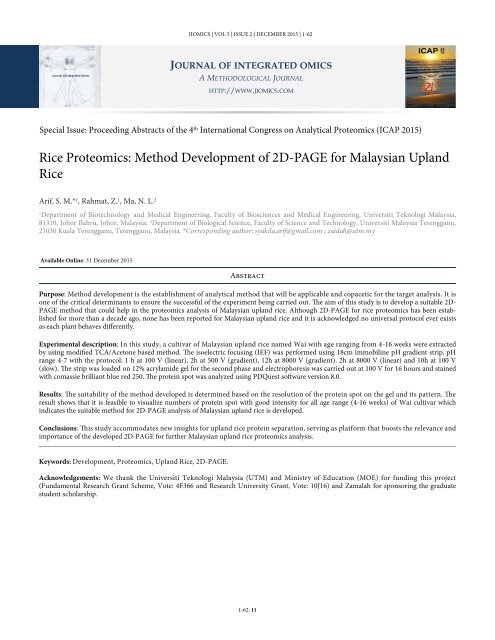JIOMICS
JIOMICS Internacional
JIOMICS Internacional
Create successful ePaper yourself
Turn your PDF publications into a flip-book with our unique Google optimized e-Paper software.
<strong>JIOMICS</strong> | VOL 5 | ISSUE 2 | DECEMBER 2015 | 1-62<br />
JOURNAL OF INTEGRATED OMICS<br />
Journal of Integrated Omics<br />
A METHODOLOGICAL JOURNAL<br />
HTTP://WWW.<strong>JIOMICS</strong>.COM<br />
Special Issue: Proceeding Abstracts of the 4 th International Congress on Analytical Proteomics (ICAP 2015)<br />
Rice Proteomics: Method Development of 2D-PAGE for Malaysian Upland<br />
Rice<br />
Arif, S. M.* 1 , Rahmat, Z. 1 , Ma, N. L. 2<br />
1<br />
Department of Biotechnology and Medical Engineering, Faculty of Biosciences and Medical Engineering, Universiti Teknologi Malaysia,<br />
81310, Johor Bahru, Johor, Malaysia. 2 Department of Biological Science, Faculty of Science and Technology, Universiti Malaysia Terengganu,<br />
21030 Kuala Terengganu, Terengganu, Malaysia. *Corresponding author: syakila.arif@gmail.com ; zaidah@utm.my<br />
Available Online: 31 December 2015<br />
Abstract<br />
Purpose: Method development is the establishment of analytical method that will be applicable and copacetic for the target analysis. It is<br />
one of the critical determinants to ensure the successful of the experiment being carried out. The aim of this study is to develop a suitable 2D-<br />
PAGE method that could help in the proteomics analysis of Malaysian upland rice. Although 2D-PAGE for rice proteomics has been established<br />
for more than a decade ago, none has been reported for Malaysian upland rice and it is acknowledged no universal protocol ever exists<br />
as each plant behaves differently.<br />
Experimental description: In this study, a cultivar of Malaysian upland rice named Wai with age ranging from 4-16 weeks were extracted<br />
by using modified TCA/Acetone based method. The isoelectric focusing (IEF) was performed using 18cm immobiline pH gradient strip, pH<br />
range 4-7 with the protocol: 1 h at 100 V (linear), 2h at 500 V (gradient), 12h at 8000 V (gradient), 2h at 8000 V (linear) and 10h at 100 V<br />
(slow). The strip was loaded on 12% acrylamide gel for the second phase and electrophoresis was carried out at 100 V for 16 hours and stained<br />
with comassie brilliant blue red 250. The protein spot was analyzed using PDQuest software version 8.0.<br />
Results: The suitability of the method developed is determined based on the resolution of the protein spot on the gel and its pattern. The<br />
result shows that it is feasible to visualize numbers of protein spot with good intensity for all age range (4-16 weeks) of Wai cultivar which<br />
indicates the suitable method for 2D-PAGE analysis of Malaysian upland rice is developed.<br />
Conclusions: This study accommodates new insights for upland rice protein separation, serving as platform that boosts the relevance and<br />
importance of the developed 2D-PAGE for further Malaysian upland rice proteomics analysis.<br />
Keywords: Development, Proteomics, Upland Rice, 2D-PAGE.<br />
Acknowledgements: We thank the Universiti Teknologi Malaysia (UTM) and Ministry of Education (MOE) for funding this project<br />
(Fundamental Research Grant Scheme, Vote: 4F366 and Research University Grant, Vote: 10J16) and Zamalah for sponsoring the graduate<br />
student scholarship.<br />
1-62: 11


